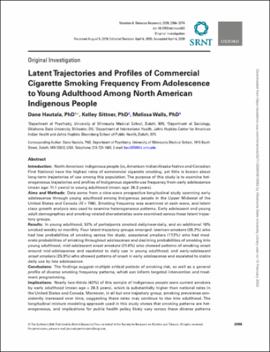| dc.contributor.author | Hautala, Dane | |
| dc.contributor.author | Sittner, Kelley | |
| dc.contributor.author | Walls, Melissa | |
| dc.date.accessioned | 2022-02-15T20:42:33Z | |
| dc.date.available | 2022-02-15T20:42:33Z | |
| dc.date.issued | 2020-11 | |
| dc.identifier | oksd_sittner_latenttrajectories_2020 | |
| dc.identifier.citation | Hautala, D., Sittner, K., & Walls, M. (2020). Latent trajectories and profiles of commercial cigarette smoking frequency from adolescence to young adulthood among North American Indigenous people. Nicotine and Tobacco Research, 22(11), pp. 2066-2074. https://doi.org/10.1093/ntr/ntaa063 | |
| dc.identifier.uri | https://hdl.handle.net/11244/334608 | |
| dc.description.abstract | Introduction: North American Indigenous people (ie, American Indian/Alaska Native and Canadian First Nations) have the highest rates of commercial cigarette smoking, yet little is known about long-term trajectories of use among this population. The purpose of this study is to examine heterogeneous trajectories and profiles of Indigenous cigarette use frequency from early adolescence (mean age: 11.1 years) to young adulthood (mean age: 26.3 years). | |
| dc.description.abstract | Aims and Methods: Data come from a nine-wave prospective longitudinal study spanning early adolescence through young adulthood among Indigenous people in the Upper Midwest of the United States and Canada (N = 706). Smoking frequency was examined at each wave, and latent class growth analysis was used to examine heterogeneous patterns. Early adolescent and young adult demographics and smoking-related characteristics were examined across these latent trajectory groups. | |
| dc.description.abstract | Results: In young adulthood, 52% of participants smoked daily/near-daily, and an additional 10% smoked weekly or monthly. Four latent trajectory groups emerged: low/non-smokers (35.2%) who had low probabilities of smoking across the study; occasional smokers (17.2%) who had moderate probabilities of smoking throughout adolescence and declining probabilities of smoking into young adulthood; mid-adolescent onset smokers (21.6%) who showed patterns of smoking onset around mid-adolescence and escalated to daily use in young adulthood; and early-adolescent onset smokers (25.9%) who showed patterns of onset in early adolescence and escalated to stable daily use by late adolescence. | |
| dc.description.abstract | Conclusions: The findings suggest multiple critical periods of smoking risk, as well as a general profile of diverse smoking frequency patterns, which can inform targeted intervention and treatment programming. | |
| dc.description.abstract | Implications: Nearly two-thirds (62%) of this sample of Indigenous people were current smokers by early adulthood (mean age = 26.3 years), which is substantially higher than national rates in the United States and Canada. Moreover, in all but one trajectory group, smoking prevalence consistently increased over time, suggesting these rates may continue to rise into adulthood. The longitudinal mixture modeling approach used in this study shows that smoking patterns are heterogeneous, and implications for public health policy likely vary across these diverse patterns characterized by timing of onset of use, escalation in frequency of use, and stability/change over time. | |
| dc.format | application/pdf | |
| dc.language | en_US | |
| dc.publisher | Oxford University Press (OUP) | |
| dc.relation.ispartof | Nicotine and Tobacco Research, 22 (11) | |
| dc.relation.uri | https://www.ncbi.nlm.nih.gov/pubmed/32270190 | |
| dc.rights | This material has been previously published. In the Oklahoma State University Library's institutional repository this version is made available through the open access principles and the terms of agreement/consent between the author(s) and the publisher. The permission policy on the use, reproduction or distribution of the material falls under fair use for educational, scholarship, and research purposes. Contact Digital Resources and Discovery Services at lib-dls@okstate.edu or 405-744-9161 for further information. | |
| dc.subject.mesh | Adolescent | |
| dc.subject.mesh | Adult | |
| dc.subject.mesh | Canada | |
| dc.subject.mesh | Child | |
| dc.subject.mesh | Cigarette Smoking | |
| dc.subject.mesh | Female | |
| dc.subject.mesh | Humans | |
| dc.subject.mesh | Indigenous Peoples | |
| dc.subject.mesh | Longitudinal Studies | |
| dc.subject.mesh | Male | |
| dc.subject.mesh | Prevalence | |
| dc.subject.mesh | Prospective Studies | |
| dc.subject.mesh | Risk Factors | |
| dc.subject.mesh | Smokers | |
| dc.subject.mesh | United States | |
| dc.subject.mesh | Young Adult | |
| dc.title | Latent trajectories and profiles of commercial cigarette smoking frequency from adolescence to young adulthood among North American Indigenous people | |
| dc.date.updated | 2022-02-09T17:49:27Z | |
| osu.filename | oksd_sittner_latenttrajectories_2020.pdf | |
| dc.description.peerreview | Peer reviewed | |
| dc.identifier.doi | 10.1093/ntr/ntaa063 | |
| dc.description.department | Sociology | |
| dc.type.genre | Article | |
| dc.type.material | Text | |
| dc.relation.oaurl | https://pubmed.ncbi.nlm.nih.gov/32270190/ | |
| dc.identifier.author | ScopusID: 57193600395 (Hautala, D) | |
| dc.identifier.author | ORCID: 0000-0002-8588-4487 (Sittner, K) | |
| dc.identifier.author | ScopusID: 55189348500 | 57195727690 (Sittner, K) | |
| dc.identifier.author | ScopusID: 14065623300 (Walls, M) | |
